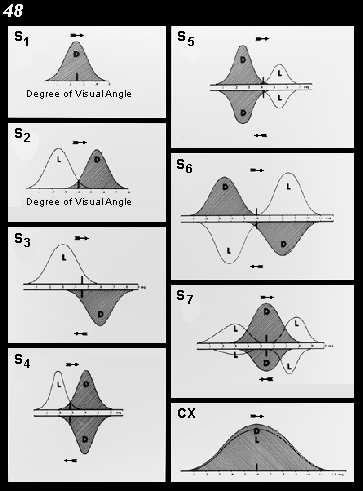The Neural
Control of Vision
K.
The Processing of Motion
 The
ability to extract motion information from the visual scene is one of
the most important tasks of the visual system. Motion in the environment,
much of it self-induced, is pervasive. Quite a number of different types
of motion have been identified that include planar, circular, radial,
as well as motion toward and away from the observer. It appears that motion
analysis is performed predominantly by neurons that are direction or velocity
selective or both. Direction-selective cells are already evident in the
retina where they form several classes and project extensively to such
structures as the terminal nuclei and the nucleus of the optic tract.
In the geniculo-striate system direction selectivity emerges in full in
the visual cortex. In V1, most of the simple cells and the majority of
the complex cells are direction specific. Figure
48 shows spatiotemporal plots of several subclasses
of simple cell plus one fully directional complex cell. The S1 cell shown
has only one subfield that responds to only dark edges and does so only
in one direction of motion. These cells, some of which respond to only
light edges are quite common. The cells labeled S1, S2, S3, S4, all have
similar subfields and would look the same were their receptive field plotted
with just stationary spots (see Figure 11, center); specifying their directional
selectivities discloses different organizations. Cells S5 and S7 demonstrate
cells that do not exhibit direction selectivity. The
ability to extract motion information from the visual scene is one of
the most important tasks of the visual system. Motion in the environment,
much of it self-induced, is pervasive. Quite a number of different types
of motion have been identified that include planar, circular, radial,
as well as motion toward and away from the observer. It appears that motion
analysis is performed predominantly by neurons that are direction or velocity
selective or both. Direction-selective cells are already evident in the
retina where they form several classes and project extensively to such
structures as the terminal nuclei and the nucleus of the optic tract.
In the geniculo-striate system direction selectivity emerges in full in
the visual cortex. In V1, most of the simple cells and the majority of
the complex cells are direction specific. Figure
48 shows spatiotemporal plots of several subclasses
of simple cell plus one fully directional complex cell. The S1 cell shown
has only one subfield that responds to only dark edges and does so only
in one direction of motion. These cells, some of which respond to only
light edges are quite common. The cells labeled S1, S2, S3, S4, all have
similar subfields and would look the same were their receptive field plotted
with just stationary spots (see Figure 11, center); specifying their directional
selectivities discloses different organizations. Cells S5 and S7 demonstrate
cells that do not exhibit direction selectivity.
|